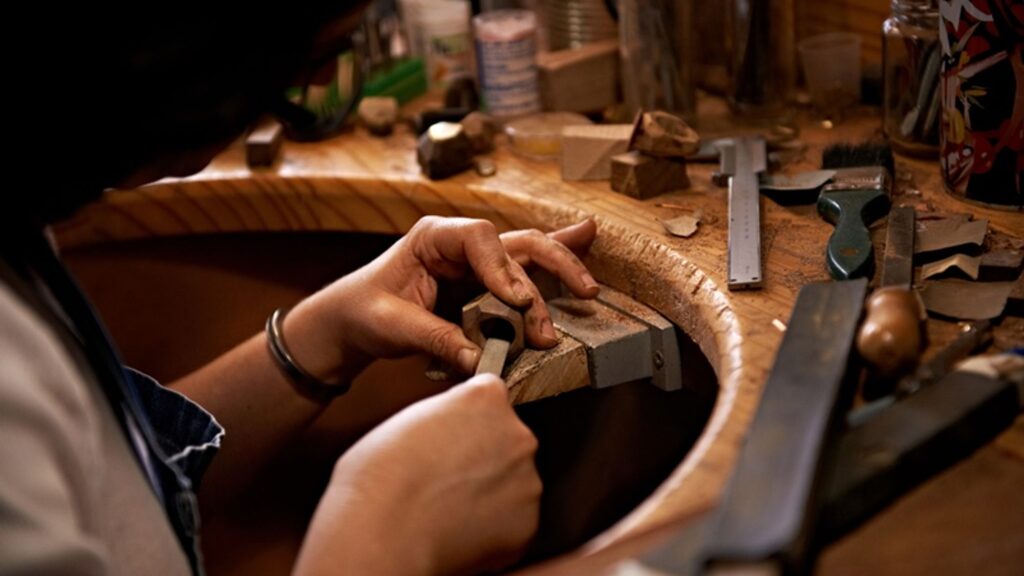Exceptional craftsmanship is more than just a term; it’s a testament to human ingenuity and dedication. In this article, we delve deep into the world of exceptional craftsmanship, uncovering its defining characteristics, historical significance, and contemporary relevance. Join us on a journey to understand the artistry and mastery behind exceptional craftsmanship.
Defining Exceptional Craftsmanship
Craftsmanship, at its core, embodies the pursuit of perfection through skill and dedication. It encompasses meticulous attention to detail, an unwavering commitment to quality, and a passion for excellence. Exceptional craftsmanship goes beyond mere proficiency; it elevates ordinary objects to works of art, imbuing them with beauty, functionality, and enduring value.
Mastery of Skills
At the heart of exceptional craftsmanship lies the mastery of skills honed through years of practice and dedication. Whether it’s woodworking, metalworking, pottery, or any other craft, artisans strive to perfect their techniques and elevate their craft to new heights. Mastery requires not only technical proficiency but also a deep understanding of materials, tools, and traditions.
Attention to Precision
Precision is the hallmark of exceptional craftsmanship. It involves painstaking attention to detail, ensuring that every cut, every stroke, and every stitch is executed with utmost care and accuracy. From intricate carvings to seamless joinery, precision elevates craftsmanship from good to extraordinary, transforming raw materials into objects of beauty and utility.
Creative Ingenuity
Exceptional craftsmanship is not merely about replicating existing designs but about pushing the boundaries of creativity and innovation. Artisans blend tradition with innovation, infusing their work with fresh ideas and unique perspectives. Whether it’s reinterpreting traditional motifs or experimenting with new materials, creative ingenuity breathes life into craftsmanship, making each piece a testament to the artisan’s vision and imagination.
Evolution and Heritage of Craftsmanship
Craftsmanship has a rich and storied history, dating back to ancient civilizations where skilled artisans crafted exquisite artifacts and architectural marvels. From the intricately carved temples of ancient Egypt to the masterful pottery of the Ming dynasty, craftsmanship has left an indelible mark on human culture and civilization.
Historical Roots
The roots of craftsmanship can be traced back to the dawn of civilization, where artisans played a vital role in shaping society and culture. In ancient times, craftsmen were revered for their skill and craftsmanship, producing objects of beauty and utility that served both practical and symbolic purposes. From the stone tools of early humans to the ornate artifacts of ancient civilizations, craftsmanship has been a driving force behind human progress and innovation.
Cultural Diversity
Craftsmanship is a universal language that transcends borders and cultures, reflecting the unique heritage and traditions of different societies. From the intricate wood carvings of Africa to the delicate porcelain of China, each culture has its own rich tradition of craftsmanship, passed down from generation to generation. Cultural diversity enriches the world of craftsmanship, inspiring artisans to draw upon a diverse array of techniques, materials, and motifs in their work.
Preservation Efforts
In an age of mass production and globalization, preserving traditional craftsmanship has become more important than ever. Organizations and initiatives around the world are dedicated to safeguarding traditional crafts and ensuring that artisanal skills are passed down to future generations. From artisan cooperatives to heritage preservation projects, these efforts play a vital role in preserving cultural heritage and promoting sustainable livelihoods for artisans.
Craftsmanship in Contemporary Context
While the world may have changed dramatically since ancient times, the spirit of craftsmanship remains as strong as ever. In today’s fast-paced, technology-driven world, artisans continue to create exceptional works of art using time-honored techniques and traditions.
Modern Applications
Craftsmanship finds expression in a wide range of industries and disciplines, from fashion and design to architecture and engineering. In the world of fashion, couture houses, and luxury brands rely on skilled artisans to create bespoke garments and accessories of exceptional quality and craftsmanship. In architecture, master builders and craftsmen collaborate to create timeless structures that stand as monuments to human creativity and ingenuity.
Challenges in the Digital Age
Despite its enduring appeal, craftsmanship faces numerous challenges in the modern world. Mass production and globalization have led to a decline in demand for handmade goods, threatening the livelihoods of artisans and craftsmen around the world. Additionally, technological advancements have transformed the way we create and consume goods, posing new challenges for traditional artisans who rely on age-old techniques and tools.
Innovations and Adaptations
In response to these challenges, artisans are embracing innovation and adapting their craft to the demands of the modern world. From incorporating digital tools and technologies into their workflow to exploring sustainable materials and practices, artisans are finding new ways to stay relevant and competitive in today’s market. By embracing change while staying true to their craft, artisans are ensuring that exceptional craftsmanship continues to thrive in the digital age.
Appreciating and Evaluating Craftsmanship
In a world flooded with mass-produced goods, exceptional craftsmanship stands out as a beacon of quality, beauty, and authenticity. Whether it’s a handcrafted piece of furniture, a bespoke garment, or a piece of artisanal pottery, craftsmanship adds a unique touch of artistry and elegance to our lives.
Discerning Quality
Appreciating exceptional craftsmanship begins with an eye for quality and attention to detail. By understanding the materials, techniques, and traditions behind a piece of craftsmanship, we can better appreciate the skill and artistry that went into its creation. From the smooth finish of a hand-carved wooden bowl to the intricate stitching of a handmade garment, quality craftsmanship is evident in every detail.
Ethical Considerations
In addition to quality, ethical considerations also play a crucial role in appreciating craftsmanship. As consumers, we have a responsibility to support artisans and craftsmen who uphold ethical and sustainable practices. By choosing handmade and artisanal products over mass-produced alternatives, we can make a positive impact on the lives of artisans and contribute to the preservation of traditional crafts and techniques.
Cultural Value
Craftsmanship is not just about creating beautiful objects; it’s also about preserving cultural heritage and fostering cultural exchange. By celebrating artisanal diversity and supporting traditional crafts from around the world, we can promote cultural understanding and appreciation. Whether it’s learning about traditional weaving techniques from indigenous communities or exploring the history of ceramics in Asia, craftsmanship offers a window into the rich tapestry of human culture and creativity.
Nurturing Future Craftsmen
As we look to the future, it’s essential to cultivate the next generation of artisans and craftsmen who will carry on the legacy of exceptional craftsmanship. Whether it’s through education, apprenticeships, or community-based initiatives, there are numerous ways to support and empower aspiring craftsmen.
Education and Training
Providing access to quality education and training is essential for nurturing future craftsmen. By offering vocational training programs and apprenticeships, we can equip young people with the skills and knowledge they need to pursue careers in craftsmanship. Additionally, educational initiatives can help raise awareness about the value of craftsmanship and inspire the next generation to embrace traditional crafts and techniques.
Supporting Artisan Communities
Empowering local artisan communities is another crucial step in nurturing future craftsmen. By supporting artisan cooperatives, fair trade organizations, and community-based initiatives, we can create economic opportunities for artisans and promote sustainable livelihoods. Additionally, initiatives that provide access to markets and resources can help artisans expand their businesses and reach new audiences.
Advocacy and Awareness
Raising awareness about the importance of craftsmanship is essential for ensuring its continued survival and relevance in the modern world. By advocating for policies that support artisanal industries and promoting the value of handmade and artisanal products, we can help create a more supportive environment for craftsmen. Additionally, engaging with policymakers, businesses, and consumers can help build a collective understanding of the importance of craftsmanship and its role in shaping our cultural identity.
Frequently Asked Questions (FAQs)
- What factors influence the cost of a bathroom remodel?
The scope of the project, materials and fixtures chosen, labor costs, and any unforeseen expenses can all impact the overall cost of a bathroom remodel.
- How can I estimate the cost of my bathroom remodel?
Estimating the cost of a bathroom remodel involves considering factors such as the size of the space, the complexity of the project, and the materials and fixtures you plan to use. Online cost estimation tools and consulting with contractors can also help provide a rough estimate.
- What is the average cost range for a bathroom remodel?
Bathroom remodel costs can vary widely depending on the scope of the project and the quality of materials and fixtures chosen. On average, a mid-range bathroom remodel can cost anywhere from $10,000 to $20,000, while a luxury remodel can cost $30,000 or more.
- Are there any hidden costs I should be aware of?
Yes, there are often hidden costs associated with bathroom remodeling, such as plumbing or electrical issues discovered during demolition, structural changes, or upgrades required to meet building codes. It’s essential to budget for contingencies to cover these unforeseen expenses.
- What are some cost-saving strategies for a bathroom remodel?
Prioritizing needs over wants, considering DIY options for simpler tasks, and exploring budget-friendly materials and fixtures are all effective cost-saving strategies for a bathroom remodel.
- What financing options are available for bathroom remodeling projects?
Financing options for bathroom remodels include personal loans, home equity loans or lines of credit, credit cards, and contractor financing programs. It’s essential to compare interest rates and terms to find the best option for your situation.
- How can I maximize the return on investment (ROI) for my bathroom remodel?
Investing in high-ROI upgrades such as energy-efficient fixtures, focusing on timeless design elements, and maintaining a balance between quality and budget can help maximize the long-term value of your bathroom remodel.
- What steps can I take to ensure the quality of my bathroom remodel?
Hiring reputable contractors, using high-quality materials, and staying involved in the remodeling process are all crucial steps to ensure the quality of your bathroom remodel. It’s also essential to communicate clearly with your contractor and address any concerns promptly.
- How long does a typical bathroom remodel take?
The duration of a bathroom remodel depends on the scope of the project, but on average, it can take anywhere from a few weeks to a few months to complete. Factors such as the availability of materials, permits, and contractor scheduling can also impact the timeline.
- What should I consider when choosing a contractor for my bathroom remodel?
When selecting a contractor, it’s essential to research their credentials, check references, and ask for a detailed written estimate. It’s also crucial to ensure that the contractor is licensed, insured, and experienced in bathroom remodeling projects. Communication and trust are key factors in establishing a successful working relationship with your contractor.
Conclusion
Exceptional craftsmanship is not just a relic of the past; it’s a living tradition that continues to inspire and captivate us today. By understanding its defining characteristics, appreciating its cultural significance, and nurturing future generations of craftsmen, we can ensure that exceptional craftsmanship continues to enrich our lives for generations to come. So let’s celebrate the artisans and craftsmen who imbue our world with beauty, creativity, and ingenuity, and let’s continue to support and uphold the values of exceptional craftsmanship in everything we do.

